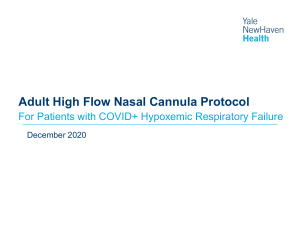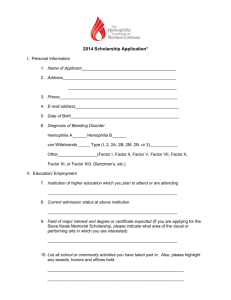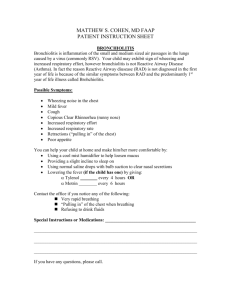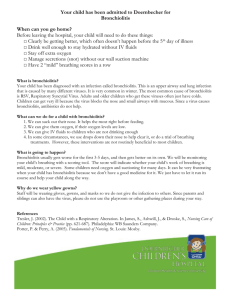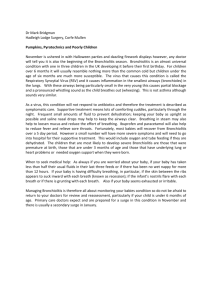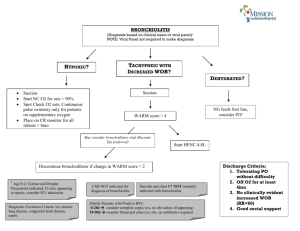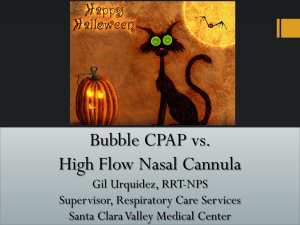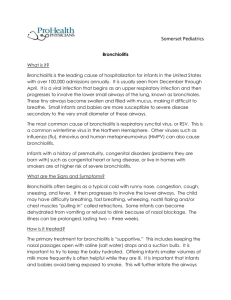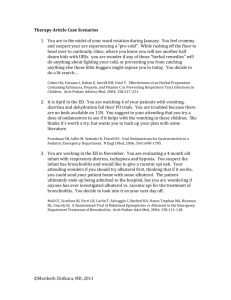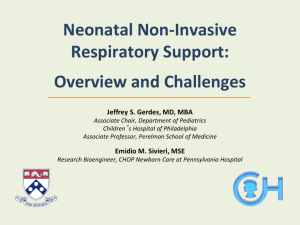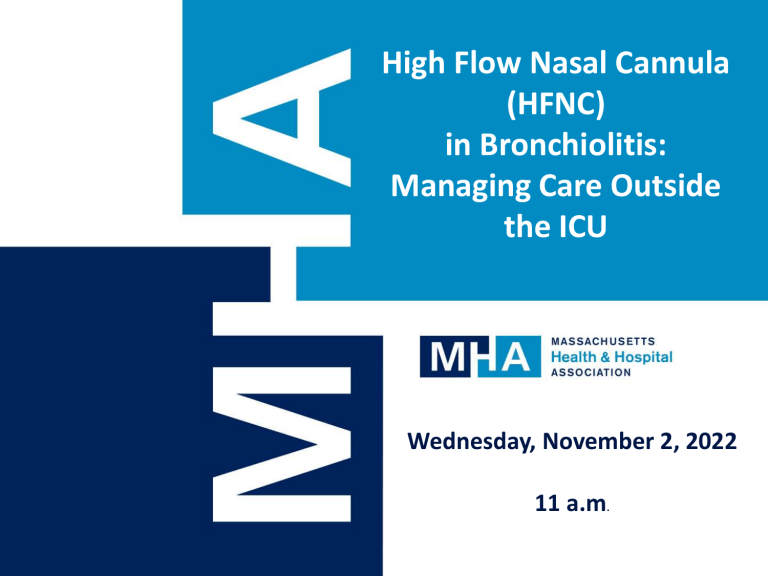
High Flow Nasal Cannula (HFNC) in Bronchiolitis: Managing Care Outside the ICU Wednesday, November 2, 2022 11 a.m. Faculty • Estevan Garcia, MD, DPH, MPA, FAAP, Chief Medical Officer, Massachusetts Department of Public Health • Alla Smith, MD, Attending Physician, Division of Medical Critical Care, Boston Children's Hospital Key Objectives The webinar is tailored to clinicians who are managing patients with bronchiolitis on HFNC outside the ICU – in both community hospitals and sites where there may be a pediatric ICU that is currently at capacity. Participants should expect to achieve the following learning objectives through this webinar: • Summarize the physiologic mechanism for HFNC in bronchiolitis; • Identify patients with bronchiolitis who may benefit from HFNC; • Discuss a weight-based approach for initiation, escalation, and weaning of HFNC; and • Assess how a pathway for management of HFNC in bronchiolitis might be implemented in your health system HFNC in Bronchiolitis: Managing Care Outside the ICU Alla Smith, 11/2/2022 High Flow Nasal Cannula Pathway HFNC in Bronchiolitis Pathway guides management of patients with bronchiolitis on HFNC using optimal flows and incorporates aggressive weaning. Goal: Bring this pathway back to your facility- adapt it to that environment Improve staff comfort with this patient population Shorten duration of critical illness/time on HFNC HFNC: What is it? Heated, humidified air with titratable FiO2 (0.21 to 1), typically delivered at flows >4L/minute HFNC: How does it help? Allows for effective dead space wash-out1 Humidifies airways, which assists with secretion clearance1 Provides (small) PEEP in patients with bronchiolitis1 Improves tachypnea and dyspnea in patients with bronchiolitis2 1. Milési, C., Baleine, J., Matecki, S., Durand, S., Combes, C., Novais, A. R. B., & Combonie, G. (2013). Is treatment with a high flow nasal cannula effective in acute viral bronchiolitis? A physiologic study. Intensive Care Medicine, 39(6), 1088–1094. 2. Rubin, S., Ghuman, A., Deakers, T., Khemani, R., Ross, P., & Newth, C. J. (2014). Effort of Breathing in Children Receiving HighFlow Nasal Cannula. Pediatric Critical Care Medicine, 15(1), 1–6. HFNC: Who should get it? Hospitalized patients with moderate to severe bronchiolitis who have failed standard therapies3 Patients with bronchiolitis (<2yo) who have Hypoxia requiring >2L/minute LFNC OR Persistent moderate to severe dyspnea or tachypnea 3. O’Brien, S. et al. ‘Rational use of high‐flow therapy in infants with bronchiolitis. What do the latest trials tell us?’ A Paediatric Research in Emergency Departments International Collaborative perspective. J Paediatr Child H 55, 746–752 (2019) HFNC: What flows are best? Most pediatric inpatient units in US use fixed liter limit flows that are low (<8LPM)4 Weight-Based Flows 2L/kg/minute are optimal5 4. Kalburgi, S. & Halley, T. High-Flow Nasal Cannula Use Outside of the ICU Setting. Pediatrics 146, e20194083 (2020) 5. Milési C, Pierre AF, Deho A, et al. A multicenter randomized controlled trial of a 3-L/kg/min versus 2-L/kg/min high-flow nasal cannula flow rate in young infants with severe viral bronchiolitis (TRAMONTANE 2). Intens Care Med. 2018;44(11):1870-1878 HFNC: Weaning is Important Higher flows are associated with longer LOS5 Aggressive weaning protocols can shorten LOS6 Regularly turn down flows and assess how patients respond 5. Milési C, Pierre AF, Deho A, et al. A multicenter randomized controlled trial of a 3-L/kg/min versus 2-L/kg/min high-flow nasal cannula flow rate in young infants with severe viral bronchiolitis (TRAMONTANE 2). Intens Care Med. 2018;44(11):1870-1878. doi:10.1007/s00134-018-5343-1 6. Sokuri P, Heikkilä P, Korppi M. National high‐flow nasal cannula and bronchiolitis survey highlights need for further research and evidence‐based guidelines. Acta Paediatr. 2017;106(12):1998-2003. doi:10.1111/apa.13964 HFNC: What to do when it fails Some studies suggest reduction in ICU need- but a proportion of children on HFNC (15-50%) will require ICU transfer7-11 Building in institution-specific transfer criteria is key to pathway success NIV with CPAP or BIPAP is a reasonable next step for most patients 7. Franklin, D., Babl, F. E., Schlapbach, L. J., Oakley, E., Craig, S., Neutze, J., et al. (2018). A Randomized Trial of HighFlow Oxygen Therapy in Infants with Bronchiolitis. The New England Journal of Medicine, 378(12), 1121–1131 8. Willer, R. J. et al. Implementation of a Weight-Based High-Flow Nasal Cannula Protocol for Children With Bronchiolitis. Hosp Pediatrics 11, 891–895 (2021) 9. Kepreotes, E., Whitehead, B., Attia, J., Oldmeadow, C., Collison, A., Searles, A., et al. (2017). High-flow warm humidified oxygen versus standard low-flow nasal cannula oxygen for moderate bronchiolitis (HFWHO RCT): an open, phase 4, randomised controlled trial. The Lancet, 389(10072), 930–939 10. Mayfield, S., Bogossian, F., O'Malley, L., & Schibler, A. (2014). High-flow nasal cannula oxygen therapy for infants with bronchiolitis: Pilot study. Journal of Paediatrics and Child Health, 50(5), 373–378 11. Clayton, J. A., McKee, B., Slain, K. N., Rotta, A. T., & Shein, S. L. (2019). Outcomes of Children With Bronchiolitis Treated With High-Flow Nasal Cannula or Noninvasive Positive Pressure Ventilation. Pediatric Critical Care Medicine, 20(2), 128–135. HFNC Pathway at a Community Hospital Average Hours on HFNC and LOS by Arm Group 90 Standard HFNC Arm 77.4 80 Weight-Based HFNC Arm 70 Hours 60 50 50.6 40.1 40 30 24.0 20 10 0 HFNC (hours) p <0.001 LOS (hours) p <0.001 HFNC Pathway at BCH Compared with Standard Practice at BCH: Reduction in Time on HFNC Reduction in Hospital and Critical Care LOS Decrease in the percentage of patients who require escalation to NIV or IMV* *preliminary data HFNC: What are the risks? Minimal. Risk of air leak is very low, even when using higher flows 7. Franklin, Recent large (~1500) patient RCT did not demonstrate any air leak7 D., Babl, F. E., Schlapbach, L. J., Oakley, E., Craig, S., Neutze, J., et al. (2018). A Randomized Trial of High-Flow Oxygen Therapy in Infants with Bronchiolitis. The New England Journal of Medicine, 378(12), 1121–1131 HFNC Pathway: RN/RT Staffing HFNC does not obviate or reduce the need for RN and RT support Patients generally staffed at 1:2 to 1:3 for nursing RT supports vary- but they are often involved in assessments/flow changes PIMCU Network Interested in high-acuity care outside the ICU? Join the PIMCU Network! Email me or the network administrator* for an invitation to the group’s website. Post questions/share pathways etc. Over 150 members nationally Join the new AAP Sub-committee on Pediatric Intermediate Care (under SOHM and SOCC) * alla.smith@childrens.harvard.edu or peter.hopkins@childrens.Harvard.edu Acknowledgements Network Team BCH Team Debra Banville Michael Agus Mark Waltzman Christiana Russ Karen Gruskin Elyse Jones Jesslyn Lenox Daria Donelly And many others! High Flow Nasal Cannula- trends Fujiogi, M. et al. Trends in Bronchiolitis Hospitalizations in the United States: 2000–2016. Pediatrics 144, e20192614 (2019). Updated: 4/27 v12 HFNC Study: Weight Based Protocol Initiate HFNC @ Initial 1 lpm/kg and 21% Oxygen Does the patient have a BASS score of mild bronchiolitis after 2 hours?* YES NO MAINTAIN: Initiate 4 hours of observation Already on max settings? YES Consider wean after 4 hours. TRANSFER CRITERIA: HR: unchanged or increased, compared with HR at HFNC initiation. RR: unchanged or increased, compared with RR at HFNC initiation. WOB: unchanged or increased, compared with WOB at HFNC initiation. Oxygen requirement >40% to maintain SpO2 >90% * Consider earlier transfer in the setting of sustained clinical worsening on maximum flow. NO Escalation to Moderate or Severe Bronchiolitis @ any time? NO NO Wean FiO2: Wean FiO2 to 21% over 2 hours. (If already on 21% go directly to wean flow.) 21% With SpO2 >90% ESCALATE: Increase to max flow rate. Maintain SpO2 >90% YES At 4 hours, 3 of the 4 Transfer Criteria* are met? Return to previous FiO2 to maintain SpO2 >90%. Monitor x2 hours NO YES Wean Flow: Cut flow in half Monitor x2 hours. Patient breathing comfortably with SpO2 >90% NO Return to previous flow Monitor x2 hours Yes Remove * consider escalating sooner if patient is decompensating YES CONSIDER TRANSFER 3/5 v4 Standard Pediatric HFNC Initiate HFNC @ Initial 4 lpm and FiO2 to maintain SpO2 >92% Patient exhibits decreased WOB and stable SpO2>92%? YES NO Increase flow to a max of 8 lpm and FiO2 to max 60% as needed to reduce WOB and maintain SpO2 >92% After a period of stability, begin wean. Decrease FiO2 by 10% down to 30% as tolerated to maintain SpO2 >92% Patient stable on 30%? Return to previous settings and monitor. NO YES Patient Improved?? YES NO Decrease flow rate as tolerated down to 1 lpm. Transfer SpO2 >92% and stable WOB on 1 lpm ? YES Remove NO Return to previous settings and monitor . Follow Up & Next Steps • Patricia Noga, PhD, RN, MBA, NEA-BC, FAAN, Vice President, Clinical Affairs, MHA – pnoga@mhalink.org • Adam Delmolino, Director, Virtual Care & Clinical Affairs, MHA – adelmolino@mhalink.org • Steve Defossez, MD, EMHL, CPE, Vice President, Clinical Integration, MHA – sdefossez@mhalink.org
